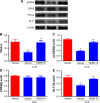cAMP/PKA/CREB/GLT1 signaling involved in the antidepressant-like effects of phosphodiesterase 4D inhibitor (GEBR-7b) in rats
- PMID: 26855578
- PMCID: PMC4725689
- DOI: 10.2147/NDT.S90960
cAMP/PKA/CREB/GLT1 signaling involved in the antidepressant-like effects of phosphodiesterase 4D inhibitor (GEBR-7b) in rats
Abstract
Objectives: GEBR-7b, a potential phosphodiesterase 4D inhibitor, has been shown to have memory-enhancing effects in rodents. However, it is still unknown whether GEBR-7b also has the antidepressant-like effects in rats. Herein, we examined the potential of GEBR-7b to attenuate depression-like behaviors in the rat model of depression induced by chronic unpredictable stress (CUS). Next, we also investigated the alterations of cyclic adenosine monophosphate (cAMP), protein kinase A (PKA) catalytic subunit (PKAca), cAMP response element-binding (CREB), and glutamate transporter 1 (GLT1) levels produced by GEBR-7b in the rats model of depression.
Methods: Effects of GEBR-7b on CUS (35 days)-induced depression-like behaviors were examined by measuring immobility time in the forced swimming test (FST). Hippocampal cAMP levels were examined by enzyme-linked immunosorbent assay, whereas PKAca, phosphorylation of CREB (pCREB), CREB, and GLT1 in the hippocampus of rats were subjected to Western blot analysis.
Results: CUS exposure caused a depression-like behavior evidenced by the increased immobility time in FST. Depression-like behavior induced by CUS was accompanied by a significant increased GLT, decreased cAMP, PKAca, pCREB activities in hippocampus. However, repeated GEBR-7b administration significantly reversed CUS-induced depression-like behavior and changes of cAMP/PKA/CREB/GLT1 signaling. No alteration was observed in locomotor activity in open field test.
Conclusion: These findings indicate that GEBR-7b reversed the depression-like behaviors induced by CUS in rats, which is at least in part mediated by modulating cAMP, PKAca, pCREB, and GLT1 levels in the hippocampus of rats, supporting its neuroprotective potential against behavioral and biochemical dysfunctions induced by CUS.
Keywords: GEBR-7b; cAMP response element-binding protein; cyclic adenosine monophosphate; glutamate transporter 1; phosphodiesterase 4D; phosphorylation of CREB; protein kinase Aca.
Figures




Similar articles
-
Improvement of spatial memory function in APPswe/PS1dE9 mice after chronic inhibition of phosphodiesterase type 4D.Neuropharmacology. 2014 Feb;77:120-30. doi: 10.1016/j.neuropharm.2013.09.015. Epub 2013 Sep 22. Neuropharmacology. 2014. PMID: 24067928
-
Effect of XingPiJieYu decoction on spatial learning and memory and cAMP-PKA-CREB-BDNF pathway in rat model of depression through chronic unpredictable stress.BMC Complement Altern Med. 2017 Jan 24;17(1):73. doi: 10.1186/s12906-016-1543-9. BMC Complement Altern Med. 2017. PMID: 28118829 Free PMC article.
-
GEBR-7b, a novel PDE4D selective inhibitor that improves memory in rodents at non-emetic doses.Br J Pharmacol. 2011 Dec;164(8):2054-63. doi: 10.1111/j.1476-5381.2011.01524.x. Br J Pharmacol. 2011. PMID: 21649644 Free PMC article.
-
Memantine treatment exerts an antidepressant-like effect by preventing hippocampal mitochondrial dysfunction and memory impairment via upregulation of CREB/BDNF signaling in the rat model of chronic unpredictable stress-induced depression.Neurochem Int. 2021 Jan;142:104932. doi: 10.1016/j.neuint.2020.104932. Epub 2020 Dec 5. Neurochem Int. 2021. PMID: 33290797
-
Helicid Ameliorates Learning and Cognitive Ability and Activities cAMP/PKA/CREB Signaling in Chronic Unpredictable Mild Stress Rats.Biol Pharm Bull. 2019;42(7):1146-1154. doi: 10.1248/bpb.b19-00012. Biol Pharm Bull. 2019. PMID: 31257291
Cited by
-
Glibenclamide Enhances the Therapeutic Benefits of Early Hypothermia after Severe Stroke in Rats.Aging Dis. 2018 Aug 1;9(4):685-695. doi: 10.14336/AD.2017.0927. eCollection 2018 Aug. Aging Dis. 2018. PMID: 30090656 Free PMC article.
-
Astrocytic Calcium and cAMP in Neurodegenerative Diseases.Front Cell Neurosci. 2022 May 19;16:889939. doi: 10.3389/fncel.2022.889939. eCollection 2022. Front Cell Neurosci. 2022. PMID: 35663426 Free PMC article. Review.
-
The cyclic AMP signaling pathway: Exploring targets for successful drug discovery (Review).Mol Med Rep. 2016 May;13(5):3715-23. doi: 10.3892/mmr.2016.5005. Epub 2016 Mar 18. Mol Med Rep. 2016. PMID: 27035868 Free PMC article. Review.
-
PDE4D: A Multipurpose Pharmacological Target.Int J Mol Sci. 2024 Jul 24;25(15):8052. doi: 10.3390/ijms25158052. Int J Mol Sci. 2024. PMID: 39125619 Free PMC article. Review.
-
Neural Plasticity Associated with Hippocampal PKA-CREB and NMDA Signaling Is Involved in the Antidepressant Effect of Repeated Low Dose of Yueju Pill on Chronic Mouse Model of Learned Helplessness.Neural Plast. 2017;2017:9160515. doi: 10.1155/2017/9160515. Epub 2017 Sep 17. Neural Plast. 2017. PMID: 29075536 Free PMC article.
References
-
- Kreiss DS, Lucki I. Effects of acute and repeated administration of antidepressant drugs on extracellular levels of 5-hydroxytryptamine measured in vivo. J Pharmacol Exp Ther. 1995;274(2):866–876. - PubMed
-
- Manji HK, Duman RS. Impairments of neuroplasticity and cellular resilience in severe mood disorders: implications for the development of novel therapeutics. Psychopharmacol Bull. 2001;35(2):5–49. - PubMed
-
- Mitchell ND, Baker GB. An update on the role of glutamate in the pathophysiology of depression. Acta Psychiatr Scand. 2010;122(3):192–210. - PubMed
LinkOut - more resources
Full Text Sources
Other Literature Sources
Miscellaneous

